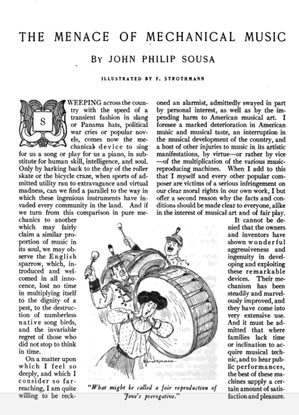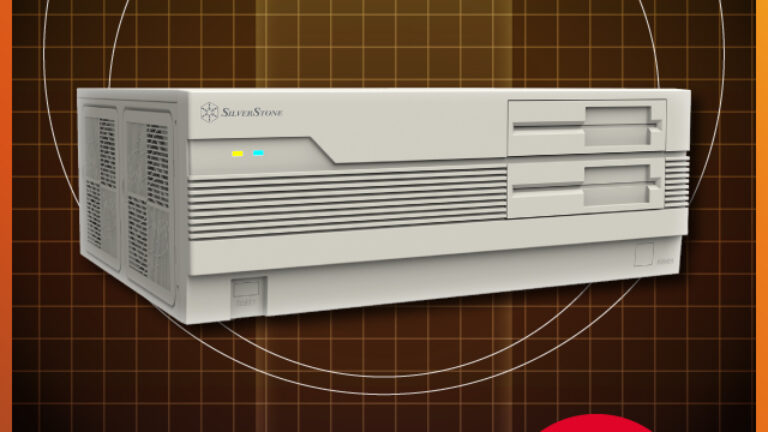100 years of Big Content fearing technology—in its own words (original) (raw)
For the last hundred years, rightsholders have fretted about everything from …
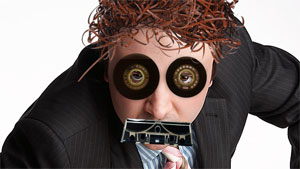
It's almost a truism in the tech world that copyright owners reflexively oppose new inventions that do (or might) disrupt existing business models. But how many techies actually know what rightsholders have said and written for the last hundred years on the subject?
The anxious rhetoric around new technology is really quite shocking in its vehemence, from claims that the player piano will destroy musical taste and the "national throat" to concerns that the VCR is like the "Boston strangler" to claims that only Hollywood's premier content could make the DTV transition a success. Most of it turned out to be absurd hyperbole, but it's interesting to see just how consistent the words and the fears remain across more than a century of innovation and a host of very different devices.
So here they are, in their own words—the copyright holders who demanded restrictions on player pianos, photocopiers, VCRs, home taping, DAT, MP3 players, Napster, the DVR, digital radio, and digital TV.
The gramophone and the player piano
In 1906, famous composer John Philip Sousa took to Appleton's Magazine to pen an essay decrying the latest piratical threat to his livelihood, to the entire body politic, and to "musical taste" itself. His concern? The player piano and the gramophone, which stripped the life from real, human, soulful live performances.
"From the days when the mathematical and mechanical were paramount in music, the struggle has been bitter and incessant for the sway of the emotional and the soulful," he wrote. "And now in this the twentieth century come these talking and playing machines and offer again to reduce the expression of music to a mathematical system of megaphones, wheels, cogs, disks, cylinders, and all manner of revolving things which are as like real art as the marble statue of Eve is like her beautiful living breathing daughters."
In fact, things were so bad that amateur music-making was threatened, something that could lead indirectly to the rampant sissification of the entire country. "Under such conditions," Sousa believed, "the tide of amateurism cannot but recede until there will be left only the mechanical device and the professional executant. Singing will no longer be a fine accomplishment; vocal exercises so important a factor in the curriculum of physical culture will be out of vogue. Then what of the national throat? Will it not weaken? What of the national chest? Will it not shrink?"
This sounds ridiculous, and in many ways it was. (Sousa opened the piece by admitting he might well be "reckoned an alarmist" on this topic.) But it wasn't completely crazy—recorded music did have an effect on the Victorian middle-class practice of singing songs around the piano for evening entertainment, and many Americans today don't sing regularly in groups at all unless they attend church or join a school choir.
Sousa's interest went beyond the "national throat and chest," though. What he really cared about was the rampant copying of his compositions for use of player pianos and other playback devices without any payment for the use of his work. "When I add to this that I myself and every other popular composer are victims of a serious infringement on our clear moral rights in our own work I but offer a second reason why the facts and conditions should be made clear to everyone alike in the interest of musical art and of fair play," he wrote.
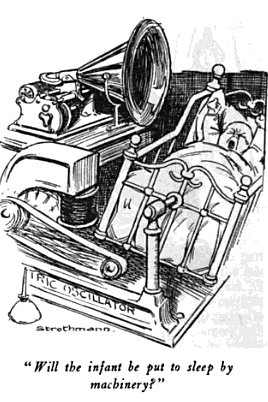
His piece concluded, "Do they not realize that if the accredited composers who have come into vogue by reason of merit and labor are refused a just reward for their efforts a condition is almost sure to arise where all incentive to further creative work is lacking and compositions will no longer flow from their pens or where they will be compelled to refrain from publishing their compositions at all and control them in manuscript? What, then, of the playing and talking machines?"
Sousa was making the argument at the heart of copyright: that it promotes innovation, and that without any protection for works, many will never be created. Though player pianos didn't put an end to composition and gramophones certainly didn't put an end to music—indeed, we're lost in our own personal libraries today—Sousa's "alarmist" rhetoric about the effects of new technology continued throughout the twentieth century and into our own. Indeed, the rhetoric increased both in volume and apocalyptic fervor, even as copyright law granted ever more rights to creators.
Photocopiers
When technological innovation took off after World War II, new products like the photocopier quickly changed entire ways of doing business. By the 1970s, such devices had caught the attention of the increasingly well-organized and professional content industries, which routinely deployed lawyers or lobbyists (and often both) to address threats to their business models.
We are going to bleed and bleed and hemorrhage, unless this Congress at least protects one industry that is able to retrieve a surplus balance of trade and whose total future depends on its protection from the savagery and the ravages of this machine.
The photocopier, invented by Xerox, became a target. In 1972, Time quoted UCLA law professor Melville Nimmer as saying, "the day may not be far off when no one need purchase books" thanks to the sinister uses of the copier. But books were hard to copy, and the process cost money. Academic journals, though, were high-priced, had low subscriber bases, and were stuffed with easily copiable articles. The copier thus represented a particular threat to these publications, several of which filed lawsuits.
One of the most famous came from Williams & Wilkins, a medical journals publisher, who went after the US government for allowing or making photocopies of articles in journals at the National Library of Medicine and the National Institutes of Health. The worry was clear: no academic would subscribe to journals anymore, but simply copy relevant articles from library copies, thereby reducing the potential market for such journals even further.
The government claimed the use was fair "since no more than one copy was made in response to each request, that the copies were made in the interest of furthering research, and that the technique was simply a mechanical improvement on the long-accepted practice of hand-copying material." The courts agreed, within certain limits (though as anyone in academia knows the issue remains contentious especially as applied to course packs).
The VCR
The copier didn't destroy academic publishing or the book business, just as the player piano and gramophone failed to destroy music. But the rhetoric around new devices just kept spiraling further out of control. In 1982, when the movie and music businesses were engaged in a full court press to shut down the hot new VCR, the warnings about its sinister effects made Sousa sound like a wimp.
Chief movie lobbyist Jack Valenti appeared at a Congressional hearing on the VCR and famously went hog-wild. "This is more than a tidal wave. It is more than an avalanche. It is here," he warned after reciting VCR import statistics. "Now, that is where the problem is. You take the high risk, which means we must go by the aftermarkets to recoup our investments. If those aftermarkets are decimated, shrunken, collapsed because of what I am going to be explaining to you in a minute, because of the fact that the VCR is stripping those things clean, those markets clean of our profit potential, you are going to have devastation in this marketplace We are going to bleed and bleed and hemorrhage, unless this Congress at least protects one industry that is able to retrieve a surplus balance of trade and whose total future depends on its protection from the savagery and the ravages of this machine."
I am one who has a belief that before the next few years the Japanese will have built into their machines an automatic situation that kills the commercial.
Blood, hemorrhage, devastation, avalanche, tidal wave, and—savagery? (Many of Valenti's comments stressed the "Japanese" nature of the VCR threat, since most devices were made there, giving his whole speech an unpleasant undertone.) But really, these comparisons were just the warmup. One lobbyist (rightly) contended that "the VCR is the greatest friend that the American film producer ever had," to which Valenti responded, "I say to you that the VCR is to the American film producer and the American public as the Boston strangler is to the woman home alone."
This wasn't just about film producers; even the American public was defenseless, alone, at the mercy of a throat-throttling invader who lurked outside in the night.
But Valenti's actual concern was far more pragmatic, much less sinister, and not really about the American public at all. He was worried about commercial skipping.
"86.8 percent of all these owners erase or skip commercials. I have here, Mr. Chairman, if you are not aware of how this works—this is [a] Panasonic. This is a little remote control device that you use on machines. It has on here channel, rewind, stop, fast forward, pause, fast advance, slow, up, down, and visual search, either going left or right
"Now, what does that mean, Mr. Chairman? It means that when you are playing back a recording, which you made two days ago or whenever—you are playing it back. You are sitting in your home in your easy chair and here comes the commercial and it is right in the middle of a Clint Eastwood film and you don't want to be interrupted. So, what do you do? You pop this beta scan and a one-minute commercial disappears in two seconds."
When asked if that was "all bad," Valenti responded in his typically colorful way. "If you are watching a Clint Eastwood film it is the most cheerful thing you can do. However, if you are an advertiser who has paid $280,000 a minute to advertise, he feels a very large pain in his stomach as well as in his checkbook because it destroys the reason for free television, the erasure, the blotting out, the fast forwarding, the visual searching, the variable beta scans. The technology is there and I am one who has a belief that before the next few years the Japanese will have built into their machines an automatic situation that kills the commercial."
And that, in turn, meant the total death of free over-the-air television.
Analog cassettes, and then, DAT
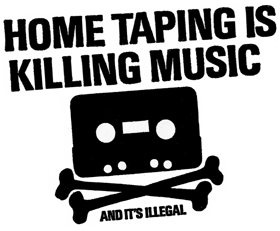
Free TV is still with us today, the VCR made billions for Hollywood, and no one was strangled, covered by an avalanche, or drowned beneath a tidal wave. But even as the VCR became a profit center both for Hollywood and the consumer electronics firms that made the devices, another threat loomed large—this time against the music industry. And once again, a famous rhetorical campaign attempted to argue that the analog cassette was literally destroying an entire industry.
That campaign was "Home Taping is Killing Music," and the music business worried that home recording from the radio and from friends' albums and cassettes spelled the end of making money with recorded music. The campaign even had its own logo, and it led to years of Congressional pressure, but music survived.
Thus, there is no personal use exemption, nor any fair use immunity for home taping. Contrary to the premise of the question, there is no distinction between commercial and home personal taping.
Later in the 1980s, the cassette threat diminished in importance as digital audio tape (DAT) appeared on the market. Capable of recording digitally, without the degradation that analog copies always suffer, pristine copies of recordings could be produced and traded infinitely without compromising the sound. Forget cassettes—it was DAT that was finally going to bury the music industry.
So the industry did what it always does: it innovated asked Congress to cripple the format. In 1987, RIAA President Jason Berman appeared before Congress to testify that "DAT poses the most significant technological threat the American music industry has ever faced."
"The studies, the market statistics, and economic analysis of the home taping problem vividly document home taping’s adverse effect on sales of records and prerecorded tapes," Berman added. "Thus, there is no personal use exemption, nor any fair use immunity for home taping. Contrary to the premise of the question, there is no distinction between commercial and home personal taping."
Initial attempts to ban and then cripple consumer DAT recorders failed, but in 1992 the music industry got Congress to pass the Audio Home Recording Act (AHRA), which mandated SCMS copy protection on DAT devices and slapped a levy on DAT tapes.
Digital music goes mainstream: MP3 players and Napster
In the 1990s, MP3 players were the new piracy threat, and the RIAA went to court against Diamond Multimedia in an effort to halt the sale of such devices. The issue went back to AHRA; was an MP3 player a covered device under the law, and did it therefore have to incorporate SCMS and collect royalties on each sale? According to the RIAA, MP3 players were covered under the law and did have to collect the royalty.
Without being able to control MP3 players, the RIAA argued, innovation would suffer. "Diamond's product Rio was destined to undermine the creation of a legitimate digital distribution marketplace," said RIAA head Hilary Rosen in 1998, "and as such we remain committed to working together with companies that make portable digital recording devices for music, so that everyone benefits."
We've come full circle here, as this is the inverse of Sousa; a new technology won't eliminate the amateurs, it will eliminate all the professionals and leave nothing but amateurs.
The RIAA initially won a temporary restraining order, but the litigation eventually went against it. MP3 players were not digital audio recording devices under AHRA, they were not required to use SCMS, and they did not need to collect royalties.
MP3 players were bad enough when it was still tough to get music off the Internet; once that became both quick and easy, a real problem developed. The music industry then turned its focus from the devices to the online services.
In 1999, the RIAA went to Napster. According to a Hilary Rosen press conference at the time, "We told them that we thought they had developed an interesting technology but that their business model was a violation of our member's copyrights. At the time they had a few thousand users. We suggested that they suspend the service and seek licenses in the same manner that all businesses that want to use copyrighted material are required to do when they start up. When they did not respond favorably we filed a lawsuit in December 1999."
Again, the service posed an existential threat to the "development of the legitimate online music market." Because of their interest in controlling that market, the labels had "been working diligently over the last two years to bring a new digital marketplace to consumers." The results were dismal; label-backed services PressPlay and MusicNet were clunky, ugly, and laden with DRM. In 2001, the Department of Justice began investigating whether the whole setup was being used for collusion, in order to gain access to sensitive pricing and contractual information, and in order to keep prices high.
After an important legal victory in the case, an RIAA press release quoted "Hound Dog" songwriter Mike Stoller, and the "death of an industry" rhetoric was trotted out once more. "Today I fear for the seventeen year old songwriter looking forward to a career in the music business," he said, "Napster.com and other companies like it are threatening not only to my retirement; they are jeopardizing the future of music itself. If Napster gets away with its thievery, it will turn that teenager's future livelihood into a mere hobby and in doing so, it will ensure that fewer and fewer talented individuals can afford to devote their efforts to expanding America's musical heritage."
We've come full circle here, as this is the inverse of Sousa; a new technology won't eliminate the amateurs, it will eliminate all the professionals and leave nothing but amateurs.
The DVR killed the video star
It's theft.
In 2002, as the digital video recorder began to creep into living rooms across America, worried TV execs wondered how to respond. Jamie Kellner, the CEO of Turner Broadcasting, knew exactly what the call the DVR and its easy commercial skipping: a tool for thieves.
In a Cableworld interview, Kellner ranted about ad skipping. "It's theft," he said. "Your contract with the network when you get the show is you're going to watch the spots. Otherwise you couldn't get the show on an ad-supported basis. Any time you skip a commercial or watch the button you're actually stealing the programming."
The comment was puzzling; had any American ever signed or agreed to such a contract? Furthermore, the interviewer pointed out that commercials have always been skipped: "What if you have to go to the bathroom or get up to get a Coke?"
Kellner was unmoved. "I guess there's a certain amount of tolerance for going to the bathroom. But if you formalize it and you create a device that skips certain second increments, you've got that only for one reason, unless you go to the bathroom for 30 seconds. They've done that just to make it easy for someone to skip a commercial."
The uneasy relationship with DVRs continued for years. In 2006, an ABC exec said that he would love nothing better than to shut down the fast-forward button on DVRs.
Radio and TV try to turn back the digital tide
In 2004, it was radio's turn to complain about digital. Going "digital" produced copies that were just too good, and something had to be done. As the industry began its shift to HD Radio, the RIAA objected to doing this without some sort of "broadcast flag" or device limitation that would make it illegal to sell certain devices—those that could read the artist information for each song, for instance, and build up an archive of digital music by that artist.
"We're in favor of HD radio," said the RIAA's Mitch Bainwol in a 2004 interview. "It offers great benefits for consumers and everyone involved, but we're not blind to several concerns. Someone could cherry-pick songs off a broadcast and fill up a personal library and then post it on Kazaa We're concerned for ourselves and the artists. If you don't have protection, it undermines the future investment in music."
The same worries extended to HDTV, which was just too good to allow without a broadcast flag that could restrict further copying. Hollywood promptly innovated went to the government, demanding a TV broadcast flag. In addition, the studios wanted the FCC to mandate the TVs and recording devices sold in the US abide by the flag, essentially using the government to dictate technological specs (the same thing would be done with DRM for the new DVD format, but through private licensing rather than government fiat).
Rather amazingly, the FCC agreed to this (PDF) in 2003. The agency was convinced by Hollywood's threat to not release any of its "high value" content for digital distribution without such protection.
"In this Report and Order, we conclude that the potential threat of mass indiscriminate redistribution will deter content owners from making high value digital content available through broadcasting outlets absent some content protection mechanism," wrote the FCC. "Although the threat of widespread indiscriminate retransmission of high value digital broadcast content is not imminent, it is forthcoming and preemptive action is needed to forestall any potential harm to the viability of over-the-air television."
And if you had any doubt that each content industry believes entirely in the "content is king" mantra, consider this line: "Supporters of a content protection system state that compelling digital broadcast programming is critical to the DTV transition and that such content is inherently at a greater risk of widespread redistribution as compared to its analog counterpart because digital media can be easily copied and distributed with little or no degradation in quality. Content owners and broadcasters uniformly assert that DTV broadcast content must be protected and that, in the absence of some protection mechanism, high value content will be withheld from broadcast television and migrate to pay services."
Not only did Hollywood make a threat to withhold content, it actually argued to the FCC that the DTV transition wouldn't work unless such content was available.
A federal court soon stomped all over this ruling, telling the FCC it couldn't dictate the way that devices would be designed just to please one industry.
Despite Hollywood's fear-mongering, the DTV transition went ahead successfully.
Conclusion
Content owners aren't always wrong to say they're being unfairly harmed (one thinks of writers like Dickens and Tolkien whose works were reprinted in the US without payment, though it did help fuel a lucrative lecture business for Dickens), and lobbyists and trade groups would be derelict if they didn't conjure up worst-case scenarios and try to keep them from happening. Unfortunately, though, as we look over the statements above, the total result of this resistance to new technology is clear: it limits (or attempts to limit) innovation.
Copyright expert William Patry put it strongly at the conclusion of his new book, Moral Panics and the Copyright Wars, writing, "I cannot think of a single significant innovation in either the creation or distribution of works of authorship that owes its origins to the copyright industries."
The great irony of these debates is that most new devices become popular only because buyers really want them, which means they open whole new markets that can then be monetized by rightsholders.
